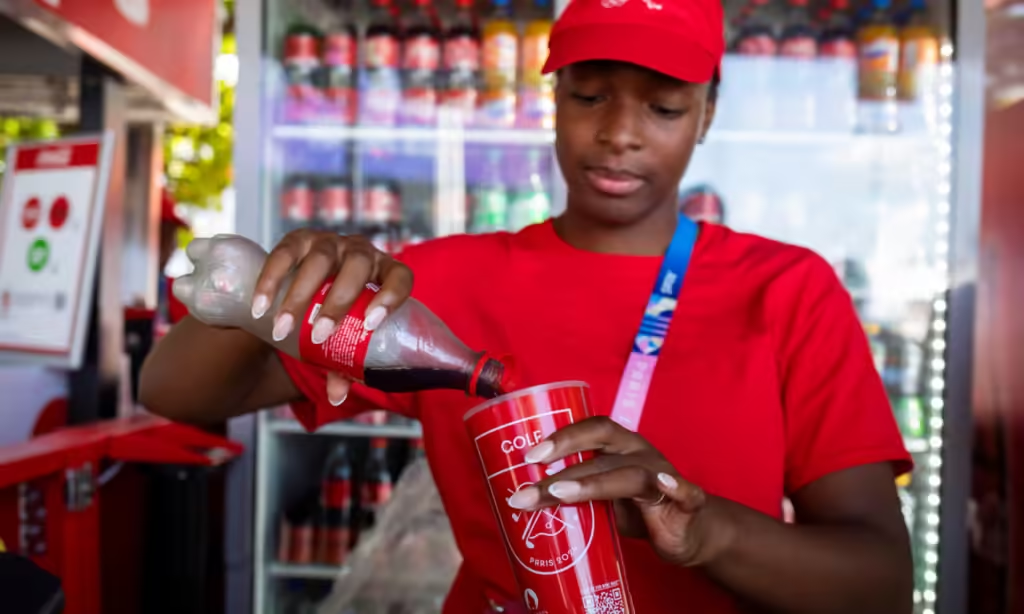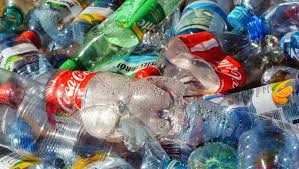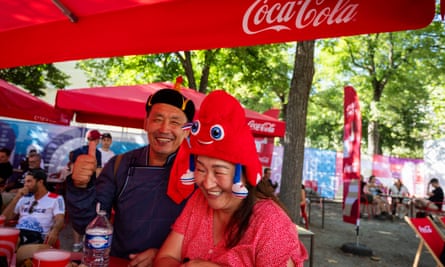
A drink company is facing criticism for its excessive use of bottles and cups, despite the fact that the organizers have promised the greenest games ever.
In comparison to London 2012, the amount of single-use plastic that was used at the Olympic Games in Paris was cut in half, making it the most environmentally friendly Games in the history of the world.
On the other hand, French environmental organizations have expressed their disapproval of what they have described as a “bizarre” and “surreal” appearance at the beverage stands run by the main sponsor, Coca-Cola, at various locations. The servers can be seen pouring plastic reusable cups, often known as “eco-cups,” from plastic bottles with a capacity of fifty centiliters, while also collecting sacks of empty bottles for recycling.
It was a double use of plastic, according to environmental activists, and it amounted to “greenwashing” that millions of plastic drink bottles were being emptied into millions of plastic cups without any reason.
Coca-Cola, the American beverage giant that is also one of the leading producers of plastics in the world, is the only company that supplies the 18 million drinks that are sold at the Olympic and Paralympic Games in Paris. These beverages include Coke, Fanta, and Sprite, and they are sold to paying spectators as well as provided to athletes at the edge of the pitch.

The organization issued a statement in which it stated that it “supports the Games’ ambitions to reduce single-use plastic” and that it was committed to recycling and decreasing waste. Following the installation of 700 soda fountains and the introduction of glass bottles, the company announced that more than half of their beverages sold at the Olympics, which amounted to 9.6 million, were “without single-use plastic.”
On the other hand, the company stated that in areas where soda fountains were not feasible to establish, around 6.2 million beverages would be supplied to the general public from recycled plastic bottles. These beverages would then be put into cups that could be reused. To guarantee that all of the empty plastic bottles were recycled, Coca-Cola would store them in a separate location. According to the firm, it was not possible to install soda fountains at all of the Games locations in order to ensure the “best conditions for safety and food quality.” This was due to the fact that there were both logistical and technical limits.
When spectators were given a plastic cup that could be returned to recoup a €2 deposit, many of them were astonished to learn that the cup was filled with a little plastic bottle. This occurred at a variety of locations during the Games, including the water polo competition at the Aquatics Centre, the tennis competition at Roland Garros, and the athletics competition at the Stade de France.

Ingrid Vanhée, who is affiliated with the Noé association, posted photographs of plastic cups and bottles at the Stade de France. She expressed her belief that fans were being “taken for idiots” and that the corporation was attempting to “win the gold medal for greenwashing.” In a post that he made from a handball event, centrist member of parliament Philippe Bolo posed the question of why, if those reusable cups were being used, they were not being filled from fountains.
“This is not a good showcase for France or Coca-Cola,” remarked Sophie Bussière, a regional councillor and spokesman for the French Green party. She was referring to the fact that plastic bottles were being poured into plastic cups.
“We really cannot continue to ruin magnificent moments of collective celebration such as the Olympics with the kind of behavior that environmental delinquents are exhibiting.”
For example, taking a plastic bottle and pouring it into a plastic reusable cup is not our idea of zero plastic, according to Marine Bonavita, who is the project leader at the non-governmental organization Zero Waste France. Many people are posting about it on social media since it is shocking not just to non-governmental organizations (NGOs), but also to the general public.
Zero Waste France, France Nature Environnement, and other non-governmental organizations issued a warning about “greenwashing” about beverages during the Games prior to their occurrence. As a precaution against the possibility of “sabotage doping” — the act of tampering with beverages—many athletes will be provided with refreshments that are supplied in plastic bottles that are single-use, sealed, and made from recycled plastic. Because of this, France’s anti-waste law, which prohibits the distribution of single-use plastic bottles in public places, has been modified to provide for an exemption on the basis of public health. The non-governmental organizations (NGOs) have written to the authorities of the French government to dispute that exemption and ask for complete details, but they have stated that they have not received a sufficient response.
Concerns have also been raised regarding the thirteen million reusable plastic cups that will be made available to spectators at the Olympic and Paralympic Games. These cups can be returned for a deposit of two euros.

It was “surreal” to watch drinks from plastic bottles poured into plastic cups, according to Muriel Papin, who is a member of the organization No Plastic in My Sea. She also described the practice as “heresy, a waste of time, and two plastics instead of one.” She stated that some viewers might consider the reusable cups to be collector’s goods and will not return them because they are eye-catchingly emblazoned with Coca-Cola colors that are special to the Paris Games.
“If people don’t give back the reusable cups, if they take them home and put them in a cupboard, or if they throw them in a bin on the street, then it’s waste,” she added. “It’s garbage.”
At the Stade de France, a number of individuals who were drinking from the reusable plastic cups that they were given at a Coca-Cola drink stand stated that they were unaware that they could return the cups. Several individuals stated that they would retain them as mementos. While he was watching the athletics, Rikke, a marketing manager from Denmark, commented, “I like the cup’s design; I’ve got Hard Rock drinking glasses at home, and I’ll add this to them.”
According to Nathalie Gontard, who is a research director at the French National Research Institute for Agriculture, Food, and the Environment and the author of the book on plastic waste titled “Plastique, Le Grand Emballement,” pouring liquid from plastic bottles into plastic cups is “a somewhat bizarre way to deal with the issue of plastic pollution.”
According to Gontard, “The public is not stupid, and everyone feels disappointed.” He went on to say that there ought to have been water fountains in every location, as well as drinking glasses that could have been washed and reused on the premises. She stated that recycling plastic, which requires a significant amount of energy and has a limited number of times it can be done, “should only be a solution for absolutely essential plastics, which these are not.”